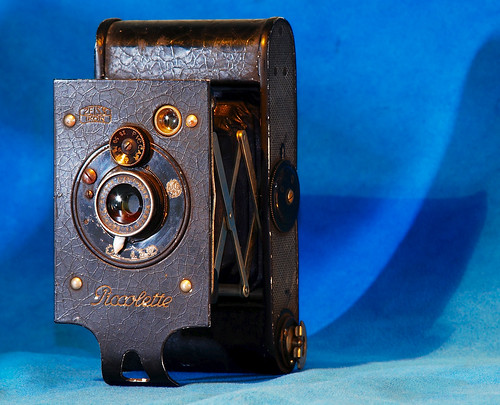Difference between revisions of "Piccolette"
| Line 13: | Line 13: | ||
The '''Piccolette''' was first made by [[Nettel]], the company which became Contessa-Nettel, as a folding-bed camera for 4x6.5 cm exposures on rollfilm, from 1914. This camera was available with various lenses, including Nettel's own Anastigmat or Rapid Aplanat, and [[Pronto]] or [[Compound]] shutter. It has radial lever focusing on the bed.<ref name=McK>{{McKeown12}} p714 (Nettel), 215 (Contessa-Nettel) and 1057 (Zeiss Ikon).</ref> | The '''Piccolette''' was first made by [[Nettel]], the company which became Contessa-Nettel, as a folding-bed camera for 4x6.5 cm exposures on rollfilm, from 1914. This camera was available with various lenses, including Nettel's own Anastigmat or Rapid Aplanat, and [[Pronto]] or [[Compound]] shutter. It has radial lever focusing on the bed.<ref name=McK>{{McKeown12}} p714 (Nettel), 215 (Contessa-Nettel) and 1057 (Zeiss Ikon).</ref> | ||
| − | However, the '''Piccolette''' is best-known as a ''strut-folding'' camera for eight 4×6.5 cm exposures on [[127 film]], made from 1919 by [[Contessa-Nettel]] in Stuttgart,<ref>[http://www.earlyphotography.co.uk/site/entry_C477.html Contessa-Nettel Piccolette], with an f/4.5 Tessar and dial-set Compur shutter, at [http://www.earlyphotography.co.uk/ Early Photography].</ref> and continued by [[Zeiss-Ikon]] after the merger in 1926 in which Contessa-Nettel joined to form Zeiss Ikon. The total production is unclear at this point.<ref>Observed Serial | + | However, the '''Piccolette''' is best-known as a ''strut-folding'' camera for eight 4×6.5 cm exposures on [[127 film]], made from 1919 by [[Contessa-Nettel]] in Stuttgart,<ref>[http://www.earlyphotography.co.uk/site/entry_C477.html Contessa-Nettel Piccolette], with an f/4.5 Tessar and dial-set Compur shutter, at [http://www.earlyphotography.co.uk/ Early Photography].</ref> and continued by [[Zeiss-Ikon]] after the merger in 1926 in which Contessa-Nettel joined to form Zeiss Ikon. The total production is unclear at this point.<ref>Observed Serial Number Ranges: |
<b>Contessa-Nettel: </b> | <b>Contessa-Nettel: </b> | ||
2822 Nettar/Derval (to be photographed); | 2822 Nettar/Derval (to be photographed); | ||
Revision as of 00:02, 12 October 2012

|
| Zeiss Ikon Piccolette image by Kimmo Kulovesi (Image rights) |
The Piccolette was first made by Nettel, the company which became Contessa-Nettel, as a folding-bed camera for 4x6.5 cm exposures on rollfilm, from 1914. This camera was available with various lenses, including Nettel's own Anastigmat or Rapid Aplanat, and Pronto or Compound shutter. It has radial lever focusing on the bed.[1]
However, the Piccolette is best-known as a strut-folding camera for eight 4×6.5 cm exposures on 127 film, made from 1919 by Contessa-Nettel in Stuttgart,[2] and continued by Zeiss-Ikon after the merger in 1926 in which Contessa-Nettel joined to form Zeiss Ikon. The total production is unclear at this point.[3] The Piccolette is more or less a copy of the Vest Pocket Kodak, and the camera was copied by Konishroku as the Pearlette.
Contessa-Nettel Piccolette 1919-1926
The camera was offered with a range of lens and shutter options:
- Achromat 7.5cm f/11 in Acro shutter
- Contessa-Nettel Piccar 7.5cm f/11 in Piccar shutter (25, 50, 75, B,T)[4]
- Contessa-Nettel Nettar Anastigmat 7.5cm f/6.8 in Derval shutter (25, 50, 100, B, T)f/6.3[5]
- Contessa Nettel Doppel Anastigmat Taronar 7.5cm f/5.4 in Compur shutter[6]
Zeiss Ikon 1926-1930
The camera was offered with a range of lens options:
- Achromat 7.5cm f/11 in Acro shutter[7]
- Trinastigmat 7.5cm f/6.8 in Derval shutter[8]
- Nettar 7.5cm f/6.8 in Derval shutter[9]
- Citonar 7.5cm f/6.3 in Derval shutter[10]
- Teronar 7.5cm f/5.4 in Compur shutter[11]
- Zeiss Tessar IIb 7.5cm f/6.3 in Compur shutter[12]
- Zeiss Tessar Ic 7.5cm f/5.4 in Compur shutter[13]
The version with the Tessar lens and turnable brilliant finder and sports finder was made from 1927 to 1930 as the Piccolette Luxus.[14] This has a folding bed in addition to struts, allowing bellows focusing, and perhaps giving a more rigid arrangement of the front standard.
Notes
- ↑ McKeown, James M. and Joan C. McKeown's Price Guide to Antique and Classic Cameras, 12th Edition, 2005-2006. USA, Centennial Photo Service, 2004. ISBN 0-931838-40-1 (hardcover). ISBN 0-931838-41-X (softcover). p714 (Nettel), 215 (Contessa-Nettel) and 1057 (Zeiss Ikon).
- ↑ Contessa-Nettel Piccolette, with an f/4.5 Tessar and dial-set Compur shutter, at Early Photography.
- ↑ Observed Serial Number Ranges: Contessa-Nettel: 2822 Nettar/Derval (to be photographed); 275191 Achromat/Acro (David Purcell); 485135 Tessar/Compur (Early Photography); Zeiss Ikon:
- ↑ Flickr
- ↑ to be photographed
- ↑ The Camerasite
- ↑ 1926-1937 Central Camera Catalog
- ↑ 1926-1937 Central Camera Catalog
- ↑ 1926-1937 Central Camera Catalog
- ↑ 1926-1937 Central Camera Catalog
- ↑ 1926-1937 Central Camera Catalog
- ↑ 1926-1937 Central Camera Catalog
- ↑ 1926-1937 Central Camera Catalog
- ↑ Piccolette de Luxe, with an f/6.4 Doppelanastigmat Citomar and dial-set compur shutter, at Early Photography.
Links
- Piccolette at Pacific Rim Camera
- Piccolette on Collection d'Appareils by Sylvain Halgand